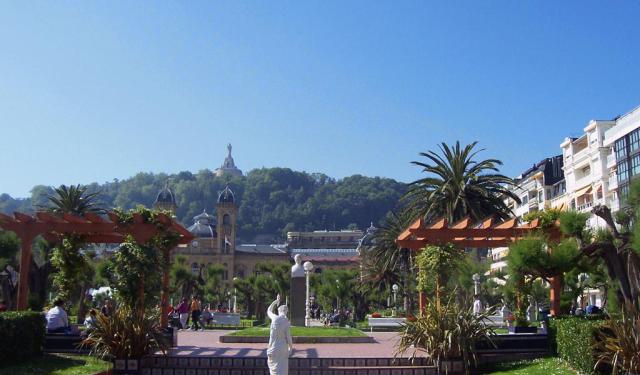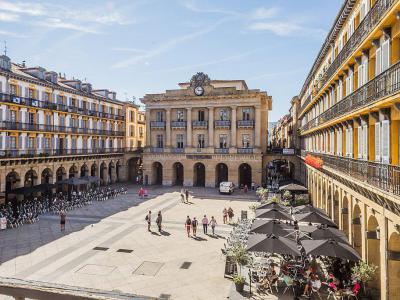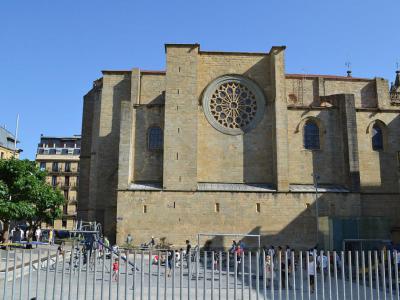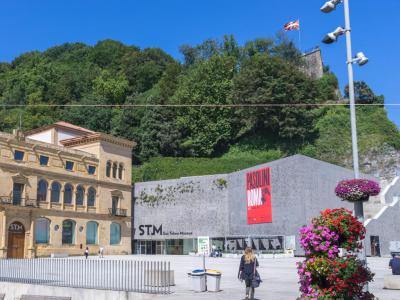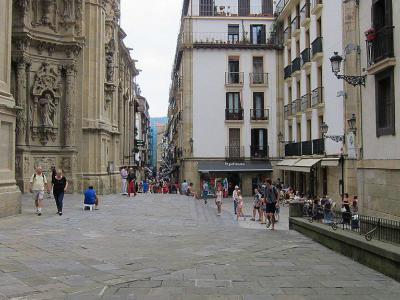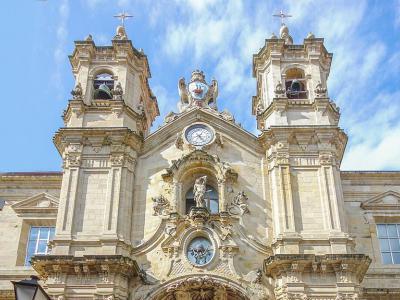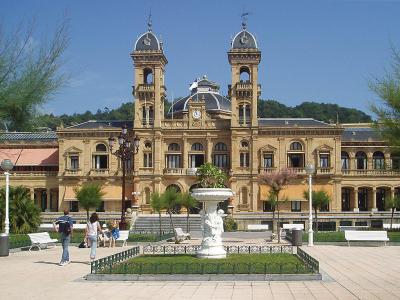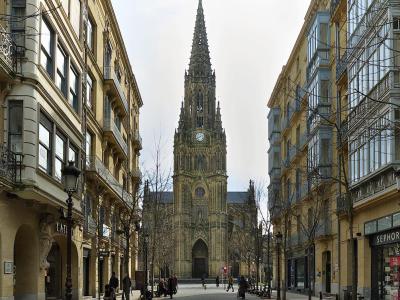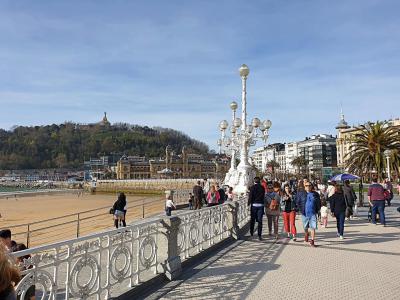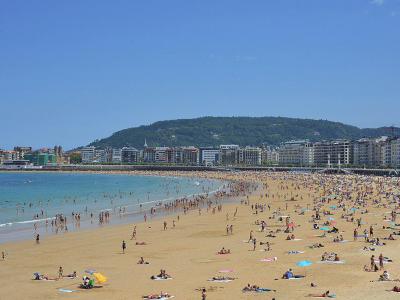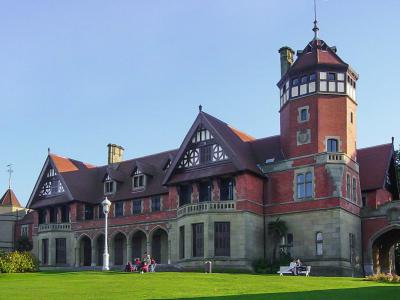Audio Guide: San Sebastian Introduction Walking Tour (Self Guided), San Sebastian
After watching bulls run around in Pamplona, Ernest Hemingway took a relaxing trip up north. He enjoyed the calmness of the shoreline so much that he vividly described it in his novel The Sun Also Rises. The city that appealed to Hemingway was San Sebastián-known in Basque as Donostia.
The city takes its name from Saint Sebastian, the early Christian martyr whose cult spread widely through medieval Iberia. The city’s natural harbor, locally known as La Concha, meaning “the shell” for its perfect crescent shape, sheltered early fishing communities and seafaring traders who recognized its strategic location between the sea and the mountain passes.
In 1181, King Sancho VI of Navarre granted San Sebastián city status, seeking to strengthen his kingdom’s maritime connections and secure a strategic outpost on the Bay of Biscay. The town’s position ensured that it became both a prize and a target. In the 15th century, the neighboring kingdoms of Navarre and Castile fought for dominance in the Basque lands. The 16th century brought further turmoil, as France and Spain clashed repeatedly during the Italian Wars.
The city’s darkest moment came in 1813, during the Peninsular War, when British and Portuguese troops expelled the French garrison but then set fire to San Sebastián. Nearly the entire old town was consumed by flames, leaving only a handful of buildings standing. This catastrophe, seared into civic memory, is still remembered every 31 August with solemn parades and ceremonies.
Out of that destruction came a new city. Reconstruction began in 1817 and gave the historic core its current neoclassical grid. By the late 19th century, San Sebastián was transformed again, this time into a glittering summer resort. Queen Isabella II and later Queen María Cristina spent their holidays along the golden sands of La Concha, elevating the beach into a symbol of royal leisure and helping the city acquire its reputation as Spain’s summer capital. The elegant seafront promenade, with its ornate balustrades, became the place to see and be seen, while grand hotels and bustling cafés turned the once-humble port into a magnet for European high society.
San Sebastián today is celebrated for its beaches, cuisine, and festivals, yet beneath the sparkle lies a history of sieges, ashes, and reinvention. Come for the calmness of the shoreline and its world-famous cuisine, but along the way you’ll uncover stories, landmarks, and layers of history that explain why this city appealed to Hemingway so deeply.
The city takes its name from Saint Sebastian, the early Christian martyr whose cult spread widely through medieval Iberia. The city’s natural harbor, locally known as La Concha, meaning “the shell” for its perfect crescent shape, sheltered early fishing communities and seafaring traders who recognized its strategic location between the sea and the mountain passes.
In 1181, King Sancho VI of Navarre granted San Sebastián city status, seeking to strengthen his kingdom’s maritime connections and secure a strategic outpost on the Bay of Biscay. The town’s position ensured that it became both a prize and a target. In the 15th century, the neighboring kingdoms of Navarre and Castile fought for dominance in the Basque lands. The 16th century brought further turmoil, as France and Spain clashed repeatedly during the Italian Wars.
The city’s darkest moment came in 1813, during the Peninsular War, when British and Portuguese troops expelled the French garrison but then set fire to San Sebastián. Nearly the entire old town was consumed by flames, leaving only a handful of buildings standing. This catastrophe, seared into civic memory, is still remembered every 31 August with solemn parades and ceremonies.
Out of that destruction came a new city. Reconstruction began in 1817 and gave the historic core its current neoclassical grid. By the late 19th century, San Sebastián was transformed again, this time into a glittering summer resort. Queen Isabella II and later Queen María Cristina spent their holidays along the golden sands of La Concha, elevating the beach into a symbol of royal leisure and helping the city acquire its reputation as Spain’s summer capital. The elegant seafront promenade, with its ornate balustrades, became the place to see and be seen, while grand hotels and bustling cafés turned the once-humble port into a magnet for European high society.
San Sebastián today is celebrated for its beaches, cuisine, and festivals, yet beneath the sparkle lies a history of sieges, ashes, and reinvention. Come for the calmness of the shoreline and its world-famous cuisine, but along the way you’ll uncover stories, landmarks, and layers of history that explain why this city appealed to Hemingway so deeply.
How it works: Download the app "GPSmyCity: Walks in 1K+ Cities" from Apple App Store or Google Play Store to your mobile phone or tablet. The app turns your mobile device into a personal tour guide and its built-in GPS navigation functions guide you from one tour stop to next. The app works offline, so no data plan is needed when traveling abroad.
San Sebastian Introduction Walking Tour Map
Guide Name: San Sebastian Introduction Walking Tour
Guide Location: Spain » San Sebastian (See other walking tours in San Sebastian)
Guide Type: Self-guided Walking Tour (Sightseeing)
# of Attractions: 10
Tour Duration: 2 Hour(s)
Travel Distance: 3.0 Km or 1.9 Miles
Author: DanaOffice
Sight(s) Featured in This Guide:
Guide Location: Spain » San Sebastian (See other walking tours in San Sebastian)
Guide Type: Self-guided Walking Tour (Sightseeing)
# of Attractions: 10
Tour Duration: 2 Hour(s)
Travel Distance: 3.0 Km or 1.9 Miles
Author: DanaOffice
Sight(s) Featured in This Guide:
- Plaza de la Constitución (Constitution Square)
- Iglesia de San Vicente Martir (Church of Saint Vicente Martir)
- Museo San Telmo (San Telmo Museum)
- Calle 31 de Agosto (August 31st Street)
- Basilica de Nuestra Senora del Coro (Basilica of Saint Mary of the Chorus)
- Ayuntamiento de San Sebastian (San Sebastian Town Hall)
- Catedral del Buen Pastor de San Sebastian (San Sebastián Cathedral)
- Paseo de la Concha (Concha Promenade)
- Playa de La Concha (La Concha Beach)
- Palacio de Miramar (Miramar Palace)
1) Plaza de la Constitución (Constitution Square) (must see)
When San Sebastián fell in September 1813, the surrender of French commander Louis Emmanuel Rey might have seemed the end of the city’s ordeal. But what followed was worse: British and Portuguese troops set the town ablaze for seven days, leaving only a few walls upright and a memory seared into the collective conscience. Out of those ashes, however, came a new San Sebastián, and at the very core of its reinvention rose Constitution Square-a showpiece of order after chaos.
Architect Ugartemendía gave the square its disciplined look in 1817, laying it out with clean neoclassical lines on the site of a more modest plaza from 1723. Twenty arches along the long sides and nine along the short formed the base for three stories of balconies, each neatly numbered. But those numbers weren’t for postmen-they were seats for bullfights, as Constitution Square doubled as the city’s arena. For decades, residents cheered from their numbered boxes as if attending the most organized blood sport in Europe.
Eventually, the bulls retired, and the square’s role shifted. The elegant neoclassical building that once housed City Hall is now the Municipal Library, while the flamboyant Gran Casino of 1887 became the new home of the council. Between them lies a plaza that traded gore for gatherings: concerts, markets, and parades took over the stage once reserved for bulls and matadors.
Today, Constitution Square wears its history lightly. The numbered balconies remain, silent witnesses to past spectacles, while the arcades below buzz with cafés, flower vendors, and chatter. Each January 20, the square shakes to the sound of the Tamborrada drum festival, and in December, the air fills with the aroma of chistorra during Saint Thomas Day. Once a bullring, now a living room, it has become the city’s most eloquent reminder that even ruins can be rebuilt into rhythm and celebration.
Architect Ugartemendía gave the square its disciplined look in 1817, laying it out with clean neoclassical lines on the site of a more modest plaza from 1723. Twenty arches along the long sides and nine along the short formed the base for three stories of balconies, each neatly numbered. But those numbers weren’t for postmen-they were seats for bullfights, as Constitution Square doubled as the city’s arena. For decades, residents cheered from their numbered boxes as if attending the most organized blood sport in Europe.
Eventually, the bulls retired, and the square’s role shifted. The elegant neoclassical building that once housed City Hall is now the Municipal Library, while the flamboyant Gran Casino of 1887 became the new home of the council. Between them lies a plaza that traded gore for gatherings: concerts, markets, and parades took over the stage once reserved for bulls and matadors.
Today, Constitution Square wears its history lightly. The numbered balconies remain, silent witnesses to past spectacles, while the arcades below buzz with cafés, flower vendors, and chatter. Each January 20, the square shakes to the sound of the Tamborrada drum festival, and in December, the air fills with the aroma of chistorra during Saint Thomas Day. Once a bullring, now a living room, it has become the city’s most eloquent reminder that even ruins can be rebuilt into rhythm and celebration.
2) Iglesia de San Vicente Martir (Church of Saint Vicente Martir)
The Church of Saint Vicente Mártir doesn’t simply sit in San Sebastián’s Old Town-it anchors it, carrying more than five centuries of memory in its stone. Dedicated to Saint Vincent of Saragossa, the 4th-century martyr, it began rising in 1507 on the footprint of an earlier parish temple. The design is a lesson in contrasts: three naves with the central one soaring higher, Gothic in spirit but softened by Basque sensibilities. Its 19th-century façade ties the threads together with a rose window, biblical carvings, and a striking modern Pietà by Jorge Oteiza, where the Virgin spreads her arms in grief and resilience.
Despite its ecclesiastical purpose, the building doesn’t hide its past as part of a fortified town. A sentry box still clings to its exterior, and loopholes on the sea-facing side remind us that this church once served double duty-house of worship and defensive outpost. Inside, slender pillars crowned with vegetal capitals support pointed arches and ribbed vaults that lift the gaze upward, away from the noise of the Old Town just beyond its doors.
Art, however, is what gives the church its most enduring voice. The 16th-century Renaissance altarpiece, richly gilded and painted, narrates the life of Christ and the Virgin with theatrical detail. At the back, Filipe de Arizmendi’s 18th-century sculptures-the “Medallion of Souls” and “Ecce Homo”-add local craftsmanship to the mix, while side chapels sponsored by prominent families turn the space into a gallery of civic pride as much as faith.
For travelers, Saint Vicente Mártir offers a direct line into San Sebastián’s oldest layers, where Gothic stone, Renaissance artistry, and centuries of devotion are still present in every arch and carving.
Despite its ecclesiastical purpose, the building doesn’t hide its past as part of a fortified town. A sentry box still clings to its exterior, and loopholes on the sea-facing side remind us that this church once served double duty-house of worship and defensive outpost. Inside, slender pillars crowned with vegetal capitals support pointed arches and ribbed vaults that lift the gaze upward, away from the noise of the Old Town just beyond its doors.
Art, however, is what gives the church its most enduring voice. The 16th-century Renaissance altarpiece, richly gilded and painted, narrates the life of Christ and the Virgin with theatrical detail. At the back, Filipe de Arizmendi’s 18th-century sculptures-the “Medallion of Souls” and “Ecce Homo”-add local craftsmanship to the mix, while side chapels sponsored by prominent families turn the space into a gallery of civic pride as much as faith.
For travelers, Saint Vicente Mártir offers a direct line into San Sebastián’s oldest layers, where Gothic stone, Renaissance artistry, and centuries of devotion are still present in every arch and carving.
3) Museo San Telmo (San Telmo Museum) (must see)
The San Telmo Museum doesn’t so much stand at the foot of Mount Urgull as it stages a centuries-long performance, with each act changing the set. It began in 1562, when a Dominican convent was built here and dedicated to Saint Elmo, patron saint of sailors. Back then San Sebastián was a fortified port town, and the friars were spiritual lifeguards for a community living by the tides. The Gothic church and Renaissance cloister they left behind still frame the story, solid and austere yet edged with a touch of elegance.
Time, of course, had its way with the convent. The 19th century expelled the friars and conscripted the building as a military barracks-proof that even sacred walls can end up drafted. By 1929, the city reclaimed the site, and a few years later it reemerged as the San Telmo Museum, encouraged by the Royal Basque Society of Friends of the Country. Founded in 1765, that society aimed to foster culture and industry, and here they secured a stage for Basque history itself.
The plot thickened in 2011, when the convent got a sleek new co-star: glass-and-steel pavilions clad in aluminum panels punctured with plant life. Suddenly, the oldest museum in the Basque Country looked very much alive in the 21st century.
Step inside, and the exhibits unfold like scenes in a kaleidoscope: prehistoric tools beside Basque folk costumes, Renaissance canvases by El Greco and Sorolla, football jerseys, bicycles, and modernist experiments by Oteiza, Chillida, and Zumeta. The former church, meanwhile, wears its history in grand murals by José María Sert, transforming devotion into drama.
San Telmo is less a museum than a mirror: it reflects the contradictions and continuities of Basque identity. Wander its cloisters or its aluminum-paneled halls, and you’ll sense how this city has always balanced the pull of tradition with the lure of reinvention.
Time, of course, had its way with the convent. The 19th century expelled the friars and conscripted the building as a military barracks-proof that even sacred walls can end up drafted. By 1929, the city reclaimed the site, and a few years later it reemerged as the San Telmo Museum, encouraged by the Royal Basque Society of Friends of the Country. Founded in 1765, that society aimed to foster culture and industry, and here they secured a stage for Basque history itself.
The plot thickened in 2011, when the convent got a sleek new co-star: glass-and-steel pavilions clad in aluminum panels punctured with plant life. Suddenly, the oldest museum in the Basque Country looked very much alive in the 21st century.
Step inside, and the exhibits unfold like scenes in a kaleidoscope: prehistoric tools beside Basque folk costumes, Renaissance canvases by El Greco and Sorolla, football jerseys, bicycles, and modernist experiments by Oteiza, Chillida, and Zumeta. The former church, meanwhile, wears its history in grand murals by José María Sert, transforming devotion into drama.
San Telmo is less a museum than a mirror: it reflects the contradictions and continuities of Basque identity. Wander its cloisters or its aluminum-paneled halls, and you’ll sense how this city has always balanced the pull of tradition with the lure of reinvention.
4) Calle 31 de Agosto (August 31st Street)
August 31st Street wears history on its stones, and not the cheerful kind. In 1813, during the Peninsular War, San Sebastián was pried from French control by British and Portuguese forces led by the Duke of Wellington. The victory was short on glory: for seven days the supposed liberators torched, looted, and brutalized the city, leaving it a smoldering ruin. Only one street, then called Trinity Street, escaped the flames, chosen as the occupiers’ headquarters. Linking the churches of San Vicente and Santa María, it became the lone thread connecting the city’s medieval fabric to the present.
After the ashes cooled, San Sebastián began again. By 1817, reconstruction gave the Old Town a neoclassical order, straight lines replacing tangled alleys. Yet August 31st Street kept its cramped façades and narrow proportions, preserving the look of the city that once was. Each year on the anniversary, candles and hymns fill the street in a sober procession, a ritual reminder of both devastation and survival.
But memory doesn’t prevent appetite. Today the same strip that once held soldiers’ commands hums with the sound of clinking glasses and laughter spilling from pintxo bars. Locals gather for a bite, visitors pause between plates, and history lingers quietly in the background. To stroll August 31st Street is to move through two cities at once-the one that burned, and the one that rose again-while sharing a table in the middle of both.
After the ashes cooled, San Sebastián began again. By 1817, reconstruction gave the Old Town a neoclassical order, straight lines replacing tangled alleys. Yet August 31st Street kept its cramped façades and narrow proportions, preserving the look of the city that once was. Each year on the anniversary, candles and hymns fill the street in a sober procession, a ritual reminder of both devastation and survival.
But memory doesn’t prevent appetite. Today the same strip that once held soldiers’ commands hums with the sound of clinking glasses and laughter spilling from pintxo bars. Locals gather for a bite, visitors pause between plates, and history lingers quietly in the background. To stroll August 31st Street is to move through two cities at once-the one that burned, and the one that rose again-while sharing a table in the middle of both.
5) Basilica de Nuestra Senora del Coro (Basilica of Saint Mary of the Chorus) (must see)
The Basilica of Saint Mary of the Chorus truly announces itself. Raised between 1743 and 1774 on the bones of a Romanesque temple, it was meant to do more than shelter the faithful. By the 18th century San Sebastián was flexing its muscles as both a fortified port and trading hub, and this church doubled as a spiritual statement and a civic boast.
Its façade belongs to the exuberant world of late Spanish Baroque, or “Churrigueresque” if you want the mouthful. Think of it as stonework turned stagecraft: twisted columns, curling scrolls, carved saints, and, center stage, the Virgin Mary herself, presiding like a leading actor. The coat of arms of San Sebastián stamps the entrance, while twin spires and a clock tower keep the whole composition from slipping into pure theater.
Step inside and the drama changes tone. The plan is rectangular, the geometry clean, but the space still overwhelms with scale. Six octagonal columns rise like stone sentinels to ribbed vaults that sweep into an 89-foot dome. Side chapels, sacristies, and alcoves carry their own treasures, from statues to devotional paintings, layering centuries of local patronage and belief.
The star of the interior, though, is the gilded main altarpiece, shimmering with 18th-century bravado. At its heart is the Virgin of the Choir, a small dark wooden carving said to have spared the basilica during the catastrophic fire of 1813. Even now she presides over mass before retreating to her niche, a cycle that ties ritual to legend.
Nowadays, the basilica is more than a grand Baroque flourish in the Old Town. It is a monument where faith, artistry, and civic pride have been negotiating space for centuries-an architectural conversation still very much alive beneath the shadow of Mount Urgull.
Its façade belongs to the exuberant world of late Spanish Baroque, or “Churrigueresque” if you want the mouthful. Think of it as stonework turned stagecraft: twisted columns, curling scrolls, carved saints, and, center stage, the Virgin Mary herself, presiding like a leading actor. The coat of arms of San Sebastián stamps the entrance, while twin spires and a clock tower keep the whole composition from slipping into pure theater.
Step inside and the drama changes tone. The plan is rectangular, the geometry clean, but the space still overwhelms with scale. Six octagonal columns rise like stone sentinels to ribbed vaults that sweep into an 89-foot dome. Side chapels, sacristies, and alcoves carry their own treasures, from statues to devotional paintings, layering centuries of local patronage and belief.
The star of the interior, though, is the gilded main altarpiece, shimmering with 18th-century bravado. At its heart is the Virgin of the Choir, a small dark wooden carving said to have spared the basilica during the catastrophic fire of 1813. Even now she presides over mass before retreating to her niche, a cycle that ties ritual to legend.
Nowadays, the basilica is more than a grand Baroque flourish in the Old Town. It is a monument where faith, artistry, and civic pride have been negotiating space for centuries-an architectural conversation still very much alive beneath the shadow of Mount Urgull.
6) Ayuntamiento de San Sebastian (San Sebastian Town Hall)
San Sebastián’s Town Hall has a past life worthy of a gossip column. Long before it housed council chambers, it was the Gran Casino, unveiled in 1887 as the city’s ultimate showpiece. Architects borrowed inspiration from Monte Carlo, and the result was pure Belle Époque spectacle. Royals and aristocrats flocked here each summer-Queen Isabella II and later Queen María Cristina brought their court, turning San Sebastián into Spain’s version of high society’s living room. The guest list glittered with the Shah of Persia, Baron Rothschild, and even a young version of Soviet politician Leon Trotsky. Local fishermen, meanwhile, were kept firmly outside, with tales that berets and espadrilles were forbidden on the gaming floor.
The casino was part of a wider wave of refinement that earned San Sebastián the nickname “Little Paris.” Grand hotels, the Victoria Eugenia Theatre, and the Cathedral of the Good Shepherd joined new trams and electric lights, pulling the seaside town firmly into the modern age. But the roulette wheels stopped abruptly in 1924 when Spain’s dictatorship outlawed gambling. The once-vibrant palace of chance stood silent until 1943, when architects Alday and Arizmendi reimagined it for a very different purpose. By 1945, the city council had taken over, trading poker tables for paperwork and making it the new seat of government.
Today the building still shows off its casino glamour. Its ornate façade faces La Concha Bay as if daring passersby to imagine the champagne-fueled soirées once held within. Now, instead of aristocrats placing bets, councillors draft policies-but the drama of its past continues to linger in its walls.
The casino was part of a wider wave of refinement that earned San Sebastián the nickname “Little Paris.” Grand hotels, the Victoria Eugenia Theatre, and the Cathedral of the Good Shepherd joined new trams and electric lights, pulling the seaside town firmly into the modern age. But the roulette wheels stopped abruptly in 1924 when Spain’s dictatorship outlawed gambling. The once-vibrant palace of chance stood silent until 1943, when architects Alday and Arizmendi reimagined it for a very different purpose. By 1945, the city council had taken over, trading poker tables for paperwork and making it the new seat of government.
Today the building still shows off its casino glamour. Its ornate façade faces La Concha Bay as if daring passersby to imagine the champagne-fueled soirées once held within. Now, instead of aristocrats placing bets, councillors draft policies-but the drama of its past continues to linger in its walls.
7) Catedral del Buen Pastor de San Sebastian (San Sebastián Cathedral) (must see)
San Sebastián Cathedral looms over the city’s modern center like a 19th-century declaration of ambition carved in sandstone. The story began in 1887, when the City Council handed over a stretch of dunes and marshland between the Urumea River and La Concha Beach for a new church. A competition was launched, and local architect Manuel de Echave won with a design inspired by the Gothic giants of Germany, particularly Cologne. The foundation stone was laid in 1888 with Queen María Cristina and the royal family present; nine years later, the cathedral was consecrated. It didn’t become the official seat of the Diocese until 1953, but by then its role as a landmark was already cemented.
The result was San Sebastián’s tallest building, a 75-meter spire reaching high above the Belle Époque city that was reinventing itself as Spain’s summer capital. Its Gothic Revival style was a deliberate contrast to the Baroque and Gothic relics of the Old Town. Inside, the cathedral unfolds in a Latin cross plan: three naves, a transept, a pentagonal sanctuary, all crowned with ribbed vaults and filled with stained glass that casts color across the stone.
Among the highlights is Josep Llimona’s sculpture of the Good Shepherd, placed before the main altar, with the Four Evangelists standing guard on nearby columns. Rose windows frame gilded altarpieces, and the apse glows with images of the apostles and the Sacred Hearts. Down below, the crypt serves as both sacristy and burial chamber, while above, the vast Walcker organ-built in 1954 with more than 10,000 pipes-still shakes the building with its resonance.
The cathedral offers not just a space for worship but also a glimpse of how San Sebastián chose to define itself in the late 19th century: modern, confident, and unafraid to echo the great Gothic traditions while staking out a character of its own.
The result was San Sebastián’s tallest building, a 75-meter spire reaching high above the Belle Époque city that was reinventing itself as Spain’s summer capital. Its Gothic Revival style was a deliberate contrast to the Baroque and Gothic relics of the Old Town. Inside, the cathedral unfolds in a Latin cross plan: three naves, a transept, a pentagonal sanctuary, all crowned with ribbed vaults and filled with stained glass that casts color across the stone.
Among the highlights is Josep Llimona’s sculpture of the Good Shepherd, placed before the main altar, with the Four Evangelists standing guard on nearby columns. Rose windows frame gilded altarpieces, and the apse glows with images of the apostles and the Sacred Hearts. Down below, the crypt serves as both sacristy and burial chamber, while above, the vast Walcker organ-built in 1954 with more than 10,000 pipes-still shakes the building with its resonance.
The cathedral offers not just a space for worship but also a glimpse of how San Sebastián chose to define itself in the late 19th century: modern, confident, and unafraid to echo the great Gothic traditions while staking out a character of its own.
8) Paseo de la Concha (Concha Promenade)
La Concha Promenade is San Sebastián’s grand stage, a graceful sweep of pavement following the arc of its famous bay from Liberty Avenue to the El Antiguo tunnel. Entirely pedestrian, it has defined the city’s image since the late 19th century, when royalty traded fortresses for parasols and San Sebastián was recast as Spain’s most fashionable resort. Queen Isabella II and later Queen María Cristina spent summers here, bringing with them a retinue of nobles, diplomats, and artists eager to parade along the shoreline in full view of one another.
The promenade itself became the backdrop for this spectacle. Its white balustrade, designed in 1910 and installed a few years later, is more than decoration-it’s practically the city’s signature, its flowing forms repeating like the rhythm of the waves they overlook. Bronze lampposts, benches, and carefully landscaped gardens completed the set, turning what had once been simple sand and surf into an outdoor salon. Along its length, the walkway ties together landmarks that echo San Sebastián’s evolution: the Alderdi Eder Gardens beside the Town Hall, the Miramar Palace built in English style for royalty, and La Perla spa, a glittering reminder of the city’s reputation as a place to see and be seen.
Flanked by Mount Urgull on one end and Mount Igeldo on the other, the promenade offers sweeping views of Santa Clara Island and the elegant facades lining the bay, including the historic Hotel Londres. Today, it’s less about royal carriages and more about joggers, cyclists, and families, yet the spirit remains the same: La Concha Promenade still frames San Sebastián’s story, one steady step at a time.
The promenade itself became the backdrop for this spectacle. Its white balustrade, designed in 1910 and installed a few years later, is more than decoration-it’s practically the city’s signature, its flowing forms repeating like the rhythm of the waves they overlook. Bronze lampposts, benches, and carefully landscaped gardens completed the set, turning what had once been simple sand and surf into an outdoor salon. Along its length, the walkway ties together landmarks that echo San Sebastián’s evolution: the Alderdi Eder Gardens beside the Town Hall, the Miramar Palace built in English style for royalty, and La Perla spa, a glittering reminder of the city’s reputation as a place to see and be seen.
Flanked by Mount Urgull on one end and Mount Igeldo on the other, the promenade offers sweeping views of Santa Clara Island and the elegant facades lining the bay, including the historic Hotel Londres. Today, it’s less about royal carriages and more about joggers, cyclists, and families, yet the spirit remains the same: La Concha Promenade still frames San Sebastián’s story, one steady step at a time.
9) Playa de La Concha (La Concha Beach) (must see)
La Concha Beach has long been the showpiece of San Sebastián, its name-“the shell”-a perfect match for the bay’s sweeping curve framed by Mount Urgull, Mount Igeldo, and Santa Clara Island. Before it drew royalty and tourists, the sheltered waters served humbler purposes, offering a safe haven for fishermen and traders. The transformation from working bay to playground for the elite came in the 19th century.
In 1845 Queen Isabella II began spending her summers here, taking to the water on her doctors’ advice. Her presence, and later that of Queen María Cristina, turned San Sebastián into Spain’s summer capital. The city responded with flair: Belle Époque villas and hotels rose along the promenade, and La Concha quickly became the favored stage for Europe’s aristocracy, artists, and diplomats. High society dubbed it the “Pearl of the Cantabrian Sea,” a title the beach still wears without effort.
The shoreline stretches 4,270 feet in golden sand, though tides occasionally squeeze its width. Festivals have long filled it with life, none more so than the August “Big Week,” when fireworks competitions, regattas, parades, and Basque rural sports spill into the bay and beyond. From here, one can follow the rocky “Parrot’s Beak” to Ondarreta Beach, take a boat to Santa Clara Island, or head straight out into the surf by canoe or sail.
Nearby landmarks enrich the setting: the sleek Nautical Club shaped like a moored vessel, the once-opulent Gran Casino, and the Alderdi Eder Gardens, where tamarisk trees shade bronze figures of Don Quixote and Sancho Panza.
Today, La Concha is still the city’s emblem, a place where elegance lingers and daily life plays out against a backdrop of history and sea air. A walk here tells the whole story of San Sebastián’s rise from fishing harbor to international resort.
In 1845 Queen Isabella II began spending her summers here, taking to the water on her doctors’ advice. Her presence, and later that of Queen María Cristina, turned San Sebastián into Spain’s summer capital. The city responded with flair: Belle Époque villas and hotels rose along the promenade, and La Concha quickly became the favored stage for Europe’s aristocracy, artists, and diplomats. High society dubbed it the “Pearl of the Cantabrian Sea,” a title the beach still wears without effort.
The shoreline stretches 4,270 feet in golden sand, though tides occasionally squeeze its width. Festivals have long filled it with life, none more so than the August “Big Week,” when fireworks competitions, regattas, parades, and Basque rural sports spill into the bay and beyond. From here, one can follow the rocky “Parrot’s Beak” to Ondarreta Beach, take a boat to Santa Clara Island, or head straight out into the surf by canoe or sail.
Nearby landmarks enrich the setting: the sleek Nautical Club shaped like a moored vessel, the once-opulent Gran Casino, and the Alderdi Eder Gardens, where tamarisk trees shade bronze figures of Don Quixote and Sancho Panza.
Today, La Concha is still the city’s emblem, a place where elegance lingers and daily life plays out against a backdrop of history and sea air. A walk here tells the whole story of San Sebastián’s rise from fishing harbor to international resort.
10) Palacio de Miramar (Miramar Palace) (must see)
Miramar Palace rises between La Concha and Ondarreta beaches, a reminder of the moment San Sebastián swapped its fortified past for royal summers and high society. The story began in the mid-19th century, when Queen Isabel II turned to the city’s waters for relief from her ailments, drawing Spain’s elite in her wake. Her successor, Queen María Cristina, widow of Alfonso XII, sealed the city’s status as a seasonal capital by commissioning a proper residence fit for a royal court.
Completed in 1893, the palace was the work of English architect Selden Wornum, who imported Tudor country house flair to the Basque coast. Gables, red brick, and Neo-Gothic touches created a decidedly British silhouette against the Bay of Biscay, while gardens rolled theatrically toward the sea. This deliberate departure from local style signaled cosmopolitan ambition at the height of San Sebastián’s Belle Époque. The Prince’s Pavilion, added in 1920, expanded the complex for a new generation of royals.
Political upheavals reshaped the palace’s fate. Abolished monarchy in 1931 meant a transfer of ownership to the city, though Franco later handed it back to the crown. By 1972, San Sebastián reclaimed the estate for good. Over the years, the palace adapted: a university, a school, and eventually a cultural venue.
Miramar Municipal Palace balances nostalgia with activity. Visitors find historic interiors-the White Room, Music Room, Library, and Royal Dining Room-largely intact, while cultural events and parts of the San Sebastián Film Festival give the building fresh life. The gardens, open to all, remain the real treasure, offering sweeping views of La Concha Bay and Santa Clara Island. Here, the city’s royal past and cultural present continue their dialogue in the open air.
Completed in 1893, the palace was the work of English architect Selden Wornum, who imported Tudor country house flair to the Basque coast. Gables, red brick, and Neo-Gothic touches created a decidedly British silhouette against the Bay of Biscay, while gardens rolled theatrically toward the sea. This deliberate departure from local style signaled cosmopolitan ambition at the height of San Sebastián’s Belle Époque. The Prince’s Pavilion, added in 1920, expanded the complex for a new generation of royals.
Political upheavals reshaped the palace’s fate. Abolished monarchy in 1931 meant a transfer of ownership to the city, though Franco later handed it back to the crown. By 1972, San Sebastián reclaimed the estate for good. Over the years, the palace adapted: a university, a school, and eventually a cultural venue.
Miramar Municipal Palace balances nostalgia with activity. Visitors find historic interiors-the White Room, Music Room, Library, and Royal Dining Room-largely intact, while cultural events and parts of the San Sebastián Film Festival give the building fresh life. The gardens, open to all, remain the real treasure, offering sweeping views of La Concha Bay and Santa Clara Island. Here, the city’s royal past and cultural present continue their dialogue in the open air.
Walking Tours in San Sebastian, Spain
Create Your Own Walk in San Sebastian
Creating your own self-guided walk in San Sebastian is easy and fun. Choose the city attractions that you want to see and a walk route map will be created just for you. You can even set your hotel as the start point of the walk.
Mount Urgull Walking Tour
Mount Urgull is a promontory stretching out at the eastern end of La Concha Bay, surrounded by water on all sides, except the one linking it to the Old Town of San Sebastian. Historically, this mount, rising 123 meters above sea level, served as a strategic defense point for the city, attesting to which now are the remnants of old fortifications with cannons still in place.
From its elevated... view more
Tour Duration: 1 Hour(s)
Travel Distance: 2.7 Km or 1.7 Miles
From its elevated... view more
Tour Duration: 1 Hour(s)
Travel Distance: 2.7 Km or 1.7 Miles
The Most Popular Cities
/ view all
